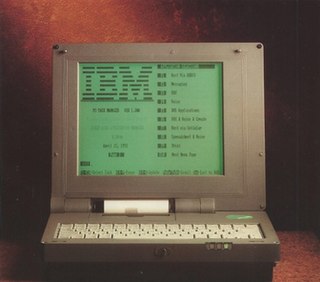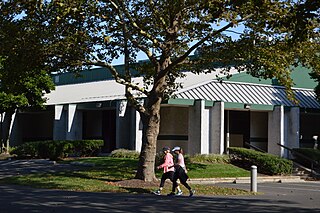IBM LAN Server is a discontinued network operating system introduced by International Business Machines (IBM) in 1988. LAN Server started as a close cousin of Microsoft's LAN Manager and first shipped in early 1988. It was originally designed to run on top of Operating System/2 (OS/2) Extended Edition. The network client was called IBM LAN Requester and was included with OS/2 EE 1.1 by default. Here the short term LAN Server refers to the IBM OS/2 LAN Server product. There were also LAN Server products for other operating systems, notably AIX—now called Fast Connect—and OS/400.

The LTE is a line of notebook-sized laptops manufactured by Compaq Computer Corporation, introduced in 1989 and discontinued in 1997. It was the first notebook computer sold by Compaq and the first commercially successful notebook that was compatible with the IBM PC.

The LTE Lite was a series of notebook-sized laptops under the LTE line manufactured by Compaq from 1992 to 1994. The first entries in the series were Compaq's first computers after co-founder Rod Canion's ousting and Eckhard Pfeiffer's tenure as the new CEO. The notebooks were co-developed and manufactured by Compaq and Citizen Watch of Japan. They were a hot-seller for Compaq and spanned multiple models, with various processors and liquid-crystal display technologies.

The PCradio was a notebook computer released by International Business Machines (IBM) in late 1991. Designed primarily for mobile workers such as service technicians, salespersons and public safety workers, the PCradio featured a ruggedized build with no internal hard disk drive and was optioned with either a cellular or ARDIS RF modem, in addition to a standard landline modem.

Reply Corporation, often shortened to Reply Corp., was an American computer company based in San Jose, California. Founded in 1988 by Steve Petracca, the company licensed the Micro Channel architecture from IBM for their own computers released in 1989, competing against IBM's PS/2 line. The company later divested from offering complete systems in favor of marketing motherboard upgrades for older PS/2s. Reply enjoyed a close relationship with IBM, owing to many of its founding employees, including Petracca, having worked for IBM. The company was acquired by Radius in 1997.

The ActionNote was a series of notebook-sized laptops developed by Epson America in 1993. The series was Epson's answer to the small businesses and home office market for laptops and initially ran alongside their corporate-oriented NB series of laptops. The series was segmented into premium and low-cost offerings and included a subnotebook, the ActionNote 4000. The bulk of the laptops' manufacturing was performed by ASE Technologies of Taiwan, with the exception of the 650 and 660 series, which were produced by Compal, and the short-lived initial entries into the 700 series, which were produced by Jabil Circuit. The ActionNote received mixed, mostly positive, reception in its lifespan before Epson America silently left the personal computer market in 1996.

Canon Computer Systems, Inc. (CCSI), sometimes shortened to Canon Computer, was an American subsidiary of Canon Inc. formed in 1992 to develop and market the parent company's personal computers and workstations. The subsidiary also assumed the responsibility of marketing Canon's printers and photocopiers, which were formerly sold by other Canon divisions. It went defunct in January 2001.
The Compaq Professional Workstation was a family of workstations produced by Compaq. Introduced in late October 1996, the first entry in the family featured single or dual Pentium Pro processors. Later entries featured Pentium IIs and IIIs; the XP1000 was the only non-x86 based entry, featuring a DEC Alpha processor. Compaq aimed the Professional Workstation at computer-aided design users, software programmers, multimedia designers and financial workers. While workers of those fields primarily ran Unix-based operating systems on workstations at the time, the Compaq Professional Workstation came preinstalled with Windows NT 4.0 Workstation. The line was discontinued in 2002.

OCR Systems, Inc., was an American computer hardware manufacturer and software publisher dedicated to optical character recognition technologies. The company's first product, the System 1000 in 1970, was used by numerous large corporations for bill processing and mail sorting. Following a series of pitfalls in the 1970s and early 1980s, founder Theodor Herzl Levine put the company in the hands of Gregory Boleslavsky and Vadim Brikman, the company's vice presidents and recent immigrants from the Soviet Ukraine, who were able to turn OCR System's fortunes around and expand its employee base. The company released the software-based OCR application ReadRight for DOS, later ported to Windows, in the late 1980s. Adobe Inc. bought the company in 1992.

Advanced Logic Research, Inc. (ALR), was an American computer company founded in 1984 in Irvine, California by Gene Lu. The company marketed IBM PC compatibles across that standard's evolution until 1997 when it was acquired by Gateway 2000.

OPTi Inc. was a fabless semiconductor company based in Milpitas, California, that primarily manufactured chipsets for personal computers. The company dissolved in 2001 and transferred its assets to the unaffiliated non-practicing entity OPTi Technologies

Aox Inc. was a privately run American technology corporation founded by Michael and Linda Aronson in 1978. Over the course of its 22-year lifespan, the company chiefly developed software and hardware for IBM's PC and compatibles, for the Personal System/2, and for the Macintosh. In its twilight years, the company designed multimedia and teleconferencing devices and chip designs. Aox was founded after Michael Aronson graduated from Harvard University with a doctorate in physics; he stayed with the company until 2000, when he incorporated EndPoints Inc. and switched to full-time fabless semiconductor design.

Cumulus Corporation was an American computer peripheral and system manufacturer active from 1987 to 1993. Based in Beachwood, Ohio and started by Tecmar founder Martin Alpert, the company set out to exclusively manufacture expansion products for IBM's Personal System/2 (PS/2) family of computers—mainly RAM expansion cards. It later released cross-platform CPU upgrade cards and memory expansion cards for other platforms besides the PS/2. Beginning in 1990, the company began trading as Cumulus Computer Corporation and began releasing complete systems of their own. Initially a success story for the tech industry in Cleveland, a botched stock launch in 1992 proved disastrous for the company's ailing cash flow situation, and in 1993 the company was liquidated amid massive debt to suppliers and lenders.
Micronics Computers, Inc. was an American computer company active from 1986 to 1998 that manufactured complete systems, motherboards, and peripherals. Based in the San Francisco Bay Area, Micronics was one of the largest domestic motherboard manufacturers in the United States in the 1990s. After acquiring Orchid Technology in 1994, the company entered the market for multimedia products, such as graphics adapters and sound cards. In 1998, Micronics was acquired by Diamond Multimedia.

The LTE Elite was a series of notebook-sized laptops under the LTE line manufactured by Compaq from 1994 to 1996. All laptops in the LTE Elite range sported Intel's i486 processors, from the 40 MHz DX2 to the 75 MHz DX4. The LTE Elite was the first notebook-sized laptop to house the AC adapter inside the case itself, eliminating the need to carry an external power brick. The LTE Elite line was replaced by the LTE 5000 series in 1995. Compaq ceased manufacturing the LTE Elite line in March 1996. Due to several recalls and a delayed rollout of the machines, the LTE Elite was overall a sales disappointment for Compaq, with rival Toshiba overtaking them as the top laptop maker in the United States in 1994 and 1995.

The LTE 5000 series was a series of notebook-sized laptops under the LTE line manufactured by Compaq from 1995 to 1997. The LTE 5000 series was Compaq's first laptop with Pentium processors from Intel. The line of computers were co-developed between Compaq and Inventec of Taiwan and were manufactured entirely by Inventec overseas. The LTE 5000 series was the last generation in the LTE line, Compaq replacing it with the Armada line in 1997.
ADI Corporation is a defunct Taiwanese manufacturing company active from 1979 to the 2000s. Its primary export was computer hardware—chiefly computer monitors—through its American subsidiary ADI Systems. For a time, it was the fifth largest monitor manufacturer in the world, with major customers including Apple, Compaq, and Optiquest.

The Satellite Pro 400 series was a series of notebook-sized laptops under the Satellite Pro line manufactured by Toshiba Information Systems from 1995 to 1999. Almost all entries in the line feature Pentium processors from Intel, with the final models featuring the Mobile Pentium II. Toshiba oriented the Satellite Pro 400 series at professionals who wanted multimedia features in a compact package; accordingly, all models feature a slot for a CD-ROM drive, built-in audio, and accelerated graphics. The Satellite Pro was a major market success for Toshiba and helped the company become the number-one global laptop manufacturer for much of the mid-1990s, beating out major competitors such as IBM and Compaq. Most models in the series received positive reception from technology journalists.
The Toshiba T series comprises personal computers sold internationally by the Japanese electronics conglomerate Toshiba, under their Information Systems subsidiary, from 1981 to 1995.














